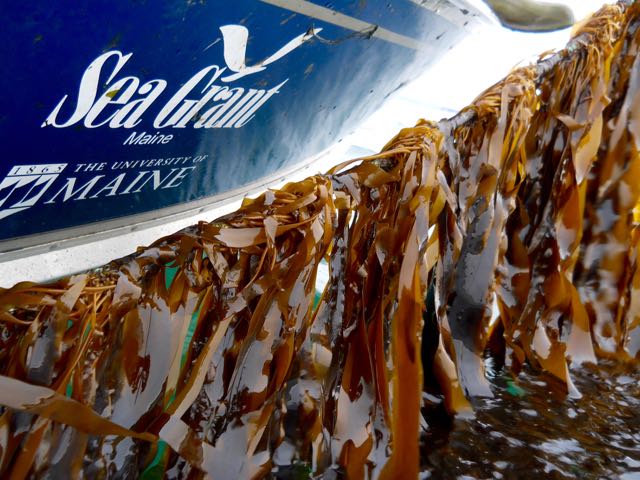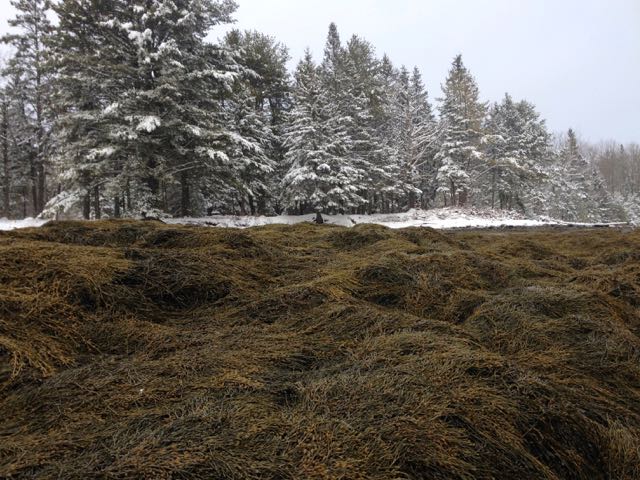Resources for Seaweed Growers
Introduction

Maine has a unique opportunity to develop a sea vegetable aquaculture industry, with its cold, clean waters, extensive coastline, and existing fishery and aquaculture industries and infrastructure. Interest in sea vegetable farming is growing in the state, as it may represent an opportunity for diversification for traditional fishermen or sea farmers. Sea vegetable aquaculture has the advantage of occurring mainly in the winter months, in the “off season” for lobstering and recreational boating, and consists of simple, submerged long line systems. Marine macroalgae also play an essential role in integrated aquaculture, providing a photosynthetic, inorganic extractive crop to shellfish or finfish farms, part of an ecologically based model that can help take up nitrogen and phosphorus and improve water quality (Chopin et al, 2001). Sea vegetables require no fertilizer or freshwater to grow, produce oxygen, take up carbon, and provide habitat and structure for other organisms. Seeded lines are produced in a land based nursery in late summer, then placed out in the fall to grow naturally on leased sea farms for approximately six to eight months.
Welcome to the Seaweed State
With its long, varied, rocky coastline, its cold, clean waters, and both a traditional wild harvest and new seaweed aquaculture industry, Maine could be considered the Seaweed State. Maine’s coastal region is home to hundreds of species of seaweeds, ancient marine macroalgae that provide essential primary production, nutrient cycling, habitat, and food to healthy ecosystems. Macroalgae are entirely of the sea, anchoring to rocks or substrate with a holdfast to provide stability, and taking all required nutrients from the sea water directly through their blades, transforming sunlight and inorganic dissolved nutrients into mineral dense organic tissue that is useful for life: animals, people, soils, or plants.
Maine has a wild harvest seaweed fishery that has been operating at a relatively small scale for over 50 years (Crawford, 1991), producing high value food, supplements, and extracts from a wide range of species in the Gulf of Maine. The seaweed fishery is regulated by the Department of Marine Resources, requiring a commercial harvesting license for the harvest, possession, shipment, transport, or sale of seaweed in Maine. Within the wild harvest industry are two major segments: rockweed and sea vegetables.
 The main species harvested in Maine is rockweed, the large, perennial, intertidal brown Ascophyllum nodosum found on rocky substrates along the coast of Maine. Rockweed was harvested and used by the Wabanaki and later European colonists, and has been commercially harvested and processed in Maine since the 1970s. Rockweed is mineral-rich and contains unique compounds that make it valuable in a wide array of uses, including for food, agriculture, supplements, feed, and soil amendments. The fresh plants are also used as packing material for shipping lobster or worms, and in cooking, for steaming seafood to impart flavor and retain moisture. Rockweed landings make up over 95% of all seaweed landings in Maine. The Department of Marine Resources is currently developing a fishery management plan for the coastwide management of this fishery, and details about the history, harvest, ecology, and management of the resource can be found in the DMR Fishery Management Plan online.
The main species harvested in Maine is rockweed, the large, perennial, intertidal brown Ascophyllum nodosum found on rocky substrates along the coast of Maine. Rockweed was harvested and used by the Wabanaki and later European colonists, and has been commercially harvested and processed in Maine since the 1970s. Rockweed is mineral-rich and contains unique compounds that make it valuable in a wide array of uses, including for food, agriculture, supplements, feed, and soil amendments. The fresh plants are also used as packing material for shipping lobster or worms, and in cooking, for steaming seafood to impart flavor and retain moisture. Rockweed landings make up over 95% of all seaweed landings in Maine. The Department of Marine Resources is currently developing a fishery management plan for the coastwide management of this fishery, and details about the history, harvest, ecology, and management of the resource can be found in the DMR Fishery Management Plan online.
The wild harvest sea vegetable sector of the industry has been providing high quality dried sea vegetables since the 1970s. Maine companies have played a key role in developing markets and products for sea vegetables in the U.S. and worldwide. While in the past sea vegetables have been primarily restricted to small, specialty “health food” markets, there is growing recognition of their ‘functional food’ properties (Holdt and Kraan, 2011), and they are becoming more popular in Western cultures as a sustainable, nutritional, local option. As awareness of the health benefits of sea vegetables rises (Mouritsen, 2013; Carignan, 2014), so does demand. Maine, especially, is seeing a great increase in demand due to quality concerns in sea vegetables sourced from the Pacific (e.g., water quality in China, radioactive concerns from Fukushima in Japan), creating an opportunity for the development of a sea vegetable aquaculture industry to sustainably meet that demand.
